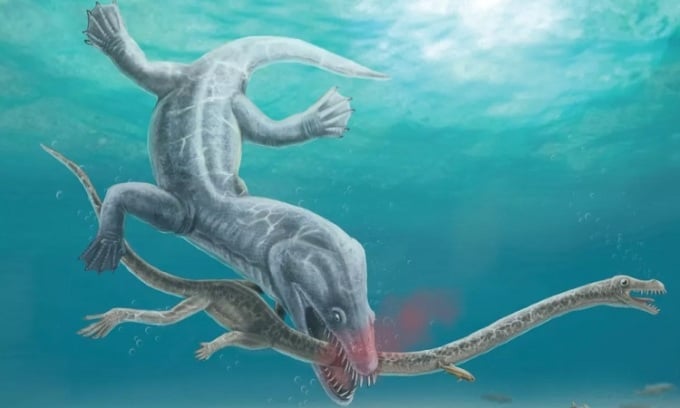A giant monster that lived 240 million years ago was killed by an enemy with a single fatal bite to its neck to eat its fleshy body.

Simulation of Tanystropheus hydroides having its neck bitten off by a larger predator. Photo: Roc Olivé
The creature whose long neck was bitten in half during the attack belonged to Tanystropheus hydroides , a marine reptile that could grow up to 6 meters long. It was an ambush predator that hunted fish and squid in tropical lagoons during the mid-Triassic period (237-247 million years ago). Tanystropheus had extremely long necks, in some cases three times longer than their bodies. The headless fossil was discovered at the Monte San Giorgio site on the border between Switzerland and Italy.
Stephan Spiekman, a vertebrate paleontologist at the Natural History Museum Stuttgart in Germany, studied two Tanystropheus specimens for his doctoral thesis at the Paleontological Museum of the University of Zurich. The first specimen was T. hydroides, while the second was T. longobardicus, a smaller species that was about 1.5 meters long.
A closer examination of the fossils revealed a severed neck with clear bite marks on several vertebrae. Spiekman and Eudald Mujal, a paleontologist at the Natural History Museum in Stuttgart, analyzed the bite marks and broken bones to find out what happened to these ancient creatures. The findings suggest that they were attacked by other predators, which targeted their long necks as a weak point.
"We found two precise tooth marks at the site of the neck fracture. This indicates that the neck was severed with a single bite. Most likely a large predator snapped the animal's neck," Spiekman explained.
In a new study published June 19 in the journal Current Biology , the team found evidence that the attack occurred from above. The predator swooped down and bit off Tanystropheus’s neck. There was no trace of the body, but the remaining head and neck were extremely well preserved. Scientists speculate that the predator targeted the long neck to quickly kill Tanystropheus and eat its meaty body.
By measuring the distance between the tooth marks, the team was able to compare the bite size to that of large carnivores that lived in the area at the time. The final list included Cymbospondylus buchseri, an ichthyosaur that could grow up to 5.5 meters long, and Nothosaurus giganteus, a giant reptile that grew to 7 meters long. A third possibility was Helveticosaurus zollingeri, a 3.6-meter carnivore with powerful forelimbs, a flexible tail, and a snout full of sharp teeth.
An Khang (According to Live Science )
Source link




















































![[Maritime News] More than 80% of global container shipping capacity is in the hands of MSC and major shipping alliances](https://vphoto.vietnam.vn/thumb/402x226/vietnam/resource/IMAGE/2025/7/16/6b4d586c984b4cbf8c5680352b9eaeb0)













































Comment (0)